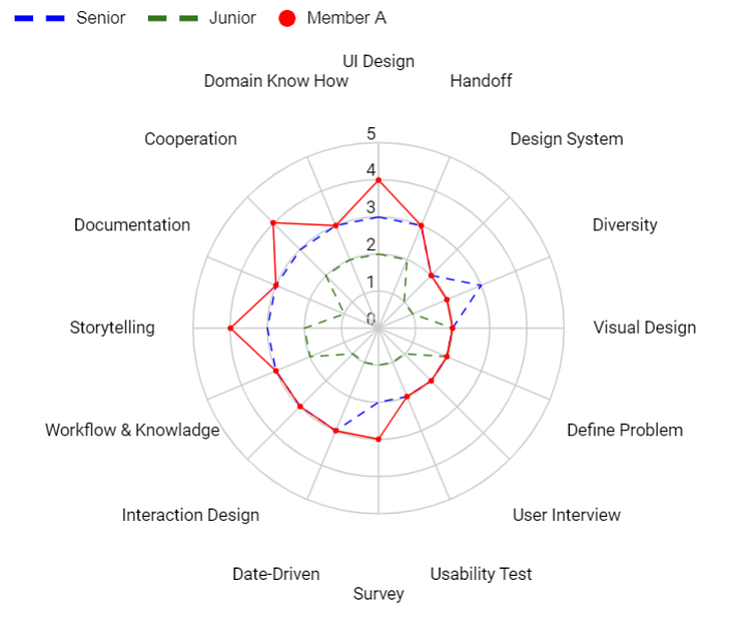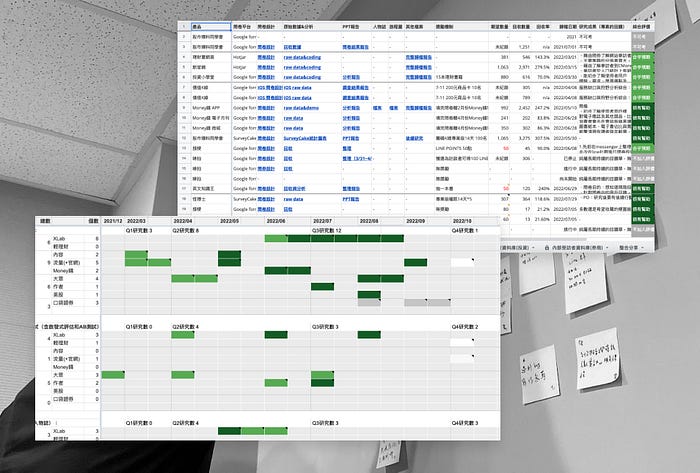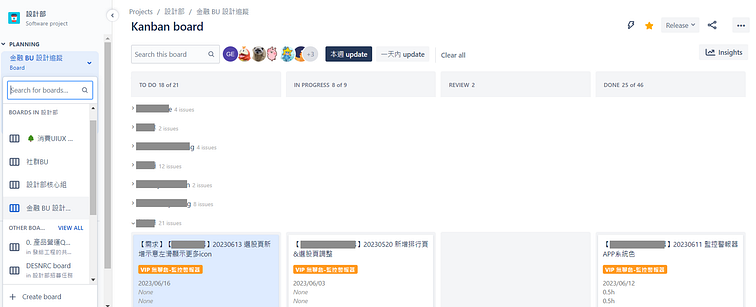How did I design a design department in a matrix organization?
Introduction
This is a comprehensive article that synthesizes my insights on various design operations sub-projects published in Chinese in 2022 and 2023. These insights stem from the core project I undertook as the inaugural Design Lead at the matrix organization CMoney ( CM ) between 2021–2023 — designing a design department.
This is a journey of change, challenge, and growth. I hope to consolidate my 2-year story via this sharing and inspire others who are establishing design teams from the ground up — just like the reference articles I have appended at the end.
Situation
When I joined CM in 2021, as a FinTech company that manages nearly a hundred apps simultaneously, CM employed a matrix organizational structure. We had approximately 10 SCRUM Teams, and this organizational structure had a low reliance on cross-departmental collaboration but with corresponding issues related to silo effects — Designers in different SCRUM Teams constantly reinvented repetitive design patterns, conducted repetitive research, and discovered repetitive insights. Additionally, they held doubts due to the lack of communication with other Teams.


A matrix organizational structure, for many companies, is an organizational framework that prioritizes flexibility in development speed. In this structure, PMs, designers, RDs, and marketers each report to SCRUM Team Product Owners, while the assessment of professional functions and the supplementation of human resources are handled by functional department heads.

In 2021, to nurture and motivate our designers’ capabilities to further CM’s success, CM decided to hire me as a Design Lead. My role aimed to lead the designers’ development and establish sustainable design operations frameworks aligned with CM’s matrix organizational structure.

Upon receiving this task, I initially considered the design department as a B2B2C system, where designers are the system’s suppliers — providing productivity to the system, and stakeholders are the customers — providing resources to the system in exchange for value. My role was that of an operator — iterating on how the system operates through design, maintaining the supplier’s productivity, and increasing customer satisfaction while helping users from both directions achieve success.
With this perspective, I applied the Design Thinking — Double Diamond approach to my administration and management.
Consequently, in the following sections, the Task includes the Discover and Define processes, while the Action involves the Development and Delivery of the directions defined.
Task
Discover
I used the following three methods to explore the current situation of designers:
1 ) “User” Interview
In my first 2 months, I swiftly scheduled numerous 1-on-1s to understand expectations from — Jr Designers, Sr Designers, Product Owners, and C-Level Managers.
2 ) Design Review
By purchasing Figma and Eagle for the team, I required designers to check their files in our shared space. This helped me grasp skills across teams and enabled learning between designers.
Detailed process:
Design tool usage one year after introduction
3 ) Focus Group
When I accumulated insights or issues, I would raise problems in our design weekly meeting for in-depth discussion with relevant members. The intricacies designers faced in Scrum Team workflows often needed 15min+ to clarify and discuss.
Detailed process:
How I iteratively created successful designer meeting strategies
Define
Through discovery, I clarified the personas of the design department’s suppliers and customers in a few months. I also learned about the product development flow of CM and the opportunities for design to have a further impact.
Detailed Process:
How I Used Design Thinking to Build a 20-Person Design Team



These tasks can be categorized into the following three main High-Level Design Principles:
1 ) Recruitment and Build Frameworks
As CM had a shortage of design personnel when I joined, I needed to recruit designers for multiple SCRUM Teams to ensure each team had sufficient human resources.
2 ) Build a knowledge base and standardization
With limited interaction between designers in the matrix org, I needed to establish knowledge-sharing mechanisms — design reviews, knowledge base, and design frameworks. This facilitated collaboration and knowledge transfer, reduced duplicate work, and improved product quality.
3 ) Multi-Domain Support
With over half of our designers individually assigned to Scrum Teams, they had to cover multiple domains like UI, UX, and visual design. I decided to provide flexible support to ensure they could focus on UX or visual specialties when needed.
Detailed Process:
How I grew the visual design team through division of labor and standardization with UI/UX designers.
Action
In the Action stage, I developed and delivered several action plans from the Define stage. Here are the details:
Recruitment and Build Frameworks
1 ) I optimized the recruitment process (Develop), resulting in a 48% conversion rate increase (Delivery) from 15%.
Detailed Process:
As a hiring manager, how I iteratively improved the recruiting process over hundreds of interviews in half a year
2 ) I established a competitive market-based salary framework, which enabled me to successfully promote 85% of existing members while attracting 14 new joiners to our team.
Detailed Process:
How I built a leveling framework for a 20+ person design team


Build a knowledge base and standardization
1 ) User Research Repository
I recruited 2 UXRs and collaborated to introduce more formal UXR into CMoney’s Scrum Teams. In one year we accumulated 50+ cases, making such research and execution the norm. Designers could reference UXR cases from other Teams via this Repository, or schedule UXR support.
Detailed Process:
UX Pioneer’s Journey (1) — How I introduced user research in stages
UX Pioneer’s Journey (2) — UXR Repository and Scoreboard

2 ) UI Guideline & System
For existing mobile app products, we have gradually introduced a set of guidelines for CIS, dos and don’ts, a shared login module, and chart component templates.

As for CMoney’s website, since only a few SCRUM Teams were involved in design and development, we directly collaborated with the Engineering Department to fully design a Design System.

Detailed Process:
Building a Design System from a Design Lead Perspective
Extended issues after having a Design System
3 ) Visual Repository
I implemented the Eagle app to store visual design cases (mainly branding and resizing) and reusable assets, accelerating daily design work and new employee onboarding speed.
Detailed process:
Driving the Growth of the Visual Design Team with Technology and Management (Part 2) — Milestones and Impact

Multi-Domain Support
I gradually built a team of about 4 people under my direct leadership within a year, leading them to support UXR, UI, and Visual Design needs. Some of the larger projects include:
- Customized systems for B2B customers
- CM’s internal evaluation system
- CM’s 2FA system
- E-commerce rewarding system
- CM’s campus recruitment event
- “Pocket Securities” CIS and Landing Page design
I used a Kanban tool in conjunction with Daily Standup to control progress and further promoted the operating methods as a template for the Sr. Designers of the SCRUM Teams.




Result
- We accumulated over 8000+ visual designs, 100+ UI specs, and 50+ UXR execution cases in our design repositories. This simultaneously improved design quality and reduced onboarding time for new designers by 50%.
- CM’s UX maturity upgraded from Level 2 to 3, with over half of the SCRUM Teams using User Testing results to assist decision-making in projects
( Detailed Process: Built a UX team and facilitated the company’s design thinking process. ) - Visual designers follow CIS and standardized design output, aligning with marketing data to develop high click-through-rate banner ad templates.

- During my independent leadership of the design department over five quarters, the department’s talent retention rate outperformed the company by 15%.
Afterword
I hope to be able to end with more images and text, but it may take a few more days to incubate. Therefore, I will temporarily make a temporary ending here and leave it for modification later. Here are some of my insights:
- User interviews with external users are similar to interviews with internal employees and job seekers. The same actions, such as screening interview subjects, preparing interview questions, pre-trial run, and post-text recording and summary, can help us obtain high-quality insights.
- It is not easy to improve the conversion rate of UXR insights into development (PM side), and sometimes the functions designed are shelved for several months due to information allocation problems between the front-end and back-end (RD side). These two points are the difficulties I did not have the opportunity to resolve during this period.
- The company is skeptical about the effectiveness of improving UX and the sophistication of design techniques. A better approach is to make multiple small iterations to adjust the organization. At the same time, the design manager (me) needs to patiently cooperate with the company’s existing product development rhythm and urgent tasks to gain more credit, to convince the company to invest in my policies in the absence of prior proof of the effectiveness of investing in UX maturity.
For now, I will share it here. Thank you for watching.
My References
Mindset
Case study of Design Career Framework
Design System creation and ROI measure
DesignOps Landscape
https://edu.userxper.com/programs/18abe225-dc30-40b0-8528-2df3daa90404
